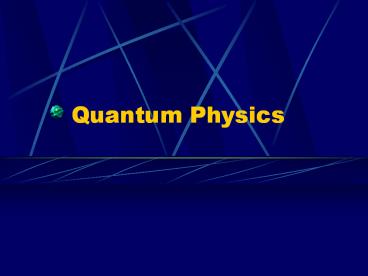Quantum Physics - PowerPoint PPT Presentation
Title: Quantum Physics
1
Quantum Physics
2
Quantum Theory
- Max Planck, examining heat radiation (ir light)
proposes energy is quantized, or occurring in
discrete small packets with a definite minimum
value. (1901) - All energy amounts were multiple of a certain
constant, called Plancks constant h with a value
of 6.63 x 10-34 Js - Energy of radiation, E hf
3
Max Planck 1858-1947
4
The Photoelectric Effect
- Hertz observed spark discharges improved with
illumination (1898) - Illumination of metal by electromagnetic
radiation causes emission of electrons - Could not be explained by wave theory
- Frequency of e-m radiation determines if emission
occurs, not intensity
5
The Photoelectric Effect
- Each metal has minimum energy that must be
supplied by light before emission occurs called
the work function of the metal. - Each metal found to have cutoff frequency of
incident light below which no emission occurs, no
matter how intense the light - Only particle theory of light could explain this
6
Einsteins Explanation
- Light consists of stream of massless particles
called photons having energy hf, moving along
electromagnetic waves (1905) - When photon strikes electron, it gives up all its
energy to the electron - If hf gt w (work function of metal), emission
occurs
7
Einsteins Explanation
- Light intensity makes no difference if frequency
is below a threshold frequency, ft - Work function of metal h ft
- Max. electron kinetic energy hf - hft
- Einstein won Nobel Prize for explanation
8
Albert Einstein 1879-1955
9
Laws of Photoelectric Emission
- Rate of emission is directly proportional to
intensity of incident light - Kinetic energy of photoelectrons is independent
of intensity of incident light. - Maximum kinetic energy of photoelectrons varies
directly with difference between frequency of
incident light and cutoff frequency of metal
10
Compton Shift
- Aurthur Compton sent X-rays into graphite
- X-rays scattered by collisions with electrons
showed longer wavelength and lower energy - Energy and momentum transferred from photon to
electron - Further support for particle nature of light
11
The Compton Shift
Arthur Compton 1892-1962
12
The Quantized Atom
- Rutherfords discovery of nucleus (1911) led to
solar system model of atom - Orbiting electrons contradicted e-m theory
- Niels Bohr (1913) proposed model of atom with
electron orbits based on quantized energy states - Difference between energy states always some
multiple of Plancks constant
13
Light Emission
- Electrons can absorb energy and jump to higher
energy level - When electrons fall to lower level, photon is
emitted whose energy equals difference in the
energy of the two levels - Since frequency depends on energy, different
energy changes cause different colors
(frequencies) of light emitted
14
Niels Bohr 1885-1962
Ernst Rutherford 1871-1937
15
Line Spectra
- Unique structure of each element results in
unique pattern of emission lines for each element
allowing identification by spectroscopy - When light passes through the element (usually as
a low pressure gas) same frequencies are absorbed
from the spectrum
16
Continuous Spectrum
- When atoms are crowded together in a solid or
dense gas, available energy levels are so
numerous, all light frequencies are emitted - White light is seen and when dispersed by a prism
or diffraction grating, all colors are seen
17
The Hydrogen Spectrum
- Hydrogen spectrum first to be analyzed
- Visible emission lines predicted and observed by
Balmer called Balmer series. - 6 uv emission lines (Lyman series) and 4 ir lines
(Paschen series) discovered later.
18
Matter and Waves
- de Broglie proposed wave-particle duality applied
to matter particles, photons must have momentum - E hf mc2 so mc h/l , photon momentum
- l h/mv , wavelength of particle with mass m and
velocity v
19
Louis de Broglie 1892-1987
20
Matter and Waves
- All matter has wave properties but for large
objects, wavelength is too small to be observed - Wave nature of electron explains why only some
orbits are stable standing wave must fit in
orbit - Whole number of wavelengths must equal
circumference of orbit
21
Matter Waves
22
(No Transcript)
23
X-Ray Production
- Reverse of photoelectric effect
- High energy electron beam strike metal causing
emission of photons - EK hfmax - w
- Frequency of photon depends on speed of electron
24
Werner Heisenberg 1901-1976
25
The Uncertainty Principle (Heisenberg, 1927)
- It is impossible to simultaneously measure
particles position and momentum accurately - Measurement of one quantity changes the other
- Electrons location can only be described by
probability
26
Erwin Schrödinger 1887-1961
27
The Wave Function
- Schrödinger (1926) proposed wave function (?)
that describes subatomic particles - Probability of electrons location can be found
using the wave function - Electron orbitals are probability distributions
called electron clouds




















![L 35 Modern Physics [1] PowerPoint PPT Presentation](https://s3.amazonaws.com/images.powershow.com/7552279.th0.jpg?_=20160119094)

![L 34 Modern Physics [1] PowerPoint PPT Presentation](https://s3.amazonaws.com/images.powershow.com/7125701.th0.jpg?_=20150905079)






![L 33 Modern Physics [1] PowerPoint PPT Presentation](https://s3.amazonaws.com/images.powershow.com/7602675.th0.jpg?_=201602121011)

